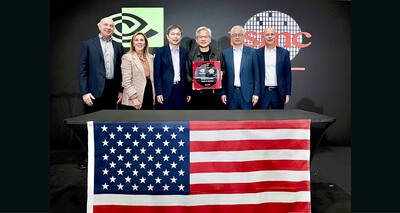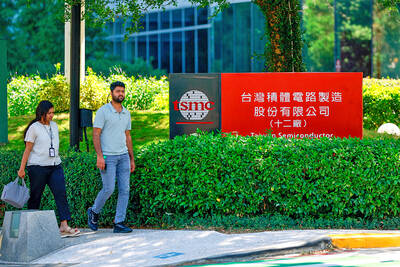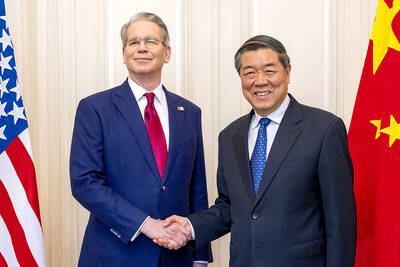FocalTech Systems Co (敦泰電子), which designs driver and touch controller ICs used in flat panels, yesterday said net income grew last quarter for a second consecutive quarter, thanks to rebounding market share and strong demand for integrated driver and controller (IDC) chips.
The company said it expected to further recoup lost market share this quarter as customers are increasing the adoption of its IDC chips for mobile phones.
IDC chips contributed 50 percent to the company’s overall revenue last quarter.
However, FocalTech said it is conservative about its business this quarter in light of the COVID-19 outbreak in China and a low-season effect for the smartphone industry.
“This adds great uncertainties to our smartphone business. Therefore, we are conservative about our business in the first quarter,” FocalTech chairman Genda Hu (胡正大) said in a statement.
The company reported that net income for last quarter plummeted 30 percent to NT$51 million (US$1.7 million), from NT$73 million in the previous quarter, with earnings per share declining from NT$0.29 to NT$0.2. It reported losses per share of NT$2.65 billion a year earlier.
Revenue expanded 9 percent quarterly and 37 percent annually to NT$2.81 billion last quarter, as the company increased the number of wafer suppliers to avoid the supply constraints incurred in 2018 and 2017.
Gross margin fell to 20.04 percent last quarter, from 23.18 percent in the previous quarter, due to intensive price competition for IDC chips, FocalTech said, adding that on an annual basis, gross margin improved from minus-8.35 percent.
The company said gross margin would improve gradually this year, buoyed by increasing adoption of next-generation IDC chips.
Last year as a whole, FocalTech posted a net loss of NT$206 million, compared with a net loss of NT$2.49 billion in 2018 and the third consecutive year of losses, which the company attributed to a wafer shortage.
Revenue slipped 8 percent to NT$9.16 billion last year from 2018, it said.

RECYCLE: Taiwan would aid manufacturers in refining rare earths from discarded appliances, which would fit the nation’s circular economy goals, minister Kung said Taiwan would work with the US and Japan on a proposed cooperation initiative in response to Beijing’s newly announced rare earth export curbs, Minister of Economic Affairs Kung Ming-hsin (龔明鑫) said yesterday. China last week announced new restrictions requiring companies to obtain export licenses if their products contain more than 0.1 percent of Chinese-origin rare earths by value. US Secretary of the Treasury Scott Bessent on Wednesday responded by saying that Beijing was “unreliable” in its rare earths exports, adding that the US would “neither be commanded, nor controlled” by China, several media outlets reported. Japanese Minister of Finance Katsunobu Kato yesterday also

Jensen Huang (黃仁勳), founder and CEO of US-based artificial intelligence chip designer Nvidia Corp and Taiwan Semiconductor Manufacturing Co (TSMC, 台積電) on Friday celebrated the first Nvidia Blackwell wafer produced on US soil. Huang visited TSMC’s advanced wafer fab in the US state of Arizona and joined the Taiwanese chipmaker’s executives to witness the efforts to “build the infrastructure that powers the world’s AI factories, right here in America,” Nvidia said in a statement. At the event, Huang joined Y.L. Wang (王英郎), vice president of operations at TSMC, in signing their names on the Blackwell wafer to

‘DRAMATIC AND POSITIVE’: AI growth would be better than it previously forecast and would stay robust even if the Chinese market became inaccessible for customers, it said Taiwan Semiconductor Manufacturing Co (TSMC, 台積電) yesterday raised its full-year revenue growth outlook after posting record profit for last quarter, despite growing market concern about an artificial intelligence (AI) bubble. The company said it expects revenue to expand about 35 percent year-on-year, driven mainly by faster-than-expected demand for leading-edge chips for AI applications. The world’s biggest contract chipmaker in July projected that revenue this year would expand about 30 percent in US dollar terms. The company also slightly hiked its capital expenditure for this year to US$40 billion to US$42 billion, compared with US$38 billion to US$42 billion it set previously. “AI demand actually

RARE EARTHS: The call between the US Treasury Secretary and his Chinese counterpart came as Washington sought to rally G7 partners in response to China’s export controls China and the US on Saturday agreed to conduct another round of trade negotiations in the coming week, as the world’s two biggest economies seek to avoid another damaging tit-for-tat tariff battle. Beijing last week announced sweeping controls on the critical rare earths industry, prompting US President Donald Trump to threaten 100 percent tariffs on imports from China in retaliation. Trump had also threatened to cancel his expected meeting with Chinese President Xi Jinping (習近平) in South Korea later this month on the sidelines of the APEC summit. In the latest indication of efforts to resolve their dispute, Chinese state media reported that